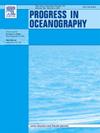Trenches apart, yet worm to worm: inter- and intra-trench comparisons reveal divergent and convergent dynamics in hadal nematode biodiversity
IF 3.6
3区 地球科学
Q1 OCEANOGRAPHY
引用次数: 0
Abstract
The hadal zone, the deepest part of the global ocean, encompasses several extreme ecosystems with elevated biological activity, contrasting the general trend of declining biomass and biodiversity with increasing water depth. These bathymetrically isolated habitats act as depocenters and are characterized by high hydrostatic pressure and unique environmental conditions that provide an opportunity to fundamentally explore biogeographic patterns and the genetic diversity of deep-sea meiofauna, which remain poorly understood. In this study, we compared nematode communities in two geographically distant trench systems, the Aleutian Trench (North Pacific) and the South Sandwich Trench (South Atlantic), separated by 17 000 km. Environmental DNA (eDNA) sequencing targeting the ribosomal 18S region was combined with a metaphylogeography approach. Comparative analyses were performed for intra- and inter-trench, biodiversity and genetic differentiation across environmentally characterised trench-specific habitats. Our findings reveal evidence for the meiofauna paradox in hadal settings, demonstrating distinct nematode communities that appear to be shaped by availability and quality of food. Furthermore, environmental filtering appeared to contribute to assembly of habitat specific communities according to localised environmental condition. Finally, we observed shared haplotypes among some dominating nematode genera, suggesting potential connectivity between habitats associated within or even across hadal trenches might exist. Overall, this study provides valuable insights on how environmental factors drive nematode biodiversity and genetic diversity in the hadal realm. Environmental heterogeneity plays a pivotal role in shaping nematode communities, influencing their population structure and connectivity by creating spatially variable habitats that drive diversification, local adaptation, and gene flow patterns.沟分开,但蠕虫对蠕虫:沟间和沟内的比较揭示了赤潮线虫生物多样性的发散和收敛动态
hadal是全球海洋最深的部分,包含了几个生物活性升高的极端生态系统,与生物量和生物多样性随着水深增加而下降的总体趋势形成鲜明对比。这些在水深上孤立的栖息地充当沉积中心,其特点是高静水压力和独特的环境条件,为从根本上探索深海小型动物的生物地理模式和遗传多样性提供了机会,这些仍然知之甚少。在这项研究中,我们比较了两个地理上遥远的海沟系统,阿留申海沟(北太平洋)和南桑威奇海沟(南大西洋),相隔17000公里的线虫群落。针对核糖体18S区域的环境DNA (eDNA)测序与变态地理方法相结合。对具有环境特征的特定海沟生境的海沟内和海沟间、生物多样性和遗传差异进行了比较分析。我们的研究结果揭示了在hadal环境中存在的微系悖论的证据,表明不同的线虫群落似乎是由食物的可获得性和质量决定的。此外,环境过滤似乎有助于根据局部环境条件聚集生境特定群落。最后,我们观察到一些优势线虫属之间存在共同的单倍型,这表明在hadal沟内甚至跨hadal沟的栖息地之间可能存在潜在的连通性。总的来说,本研究为环境因素如何驱动hadal领域的线虫生物多样性和遗传多样性提供了有价值的见解。环境异质性在塑造线虫群落、影响其种群结构和连通性方面发挥着关键作用,通过创造空间可变的栖息地来驱动多样化、地方适应和基因流动模式。
本文章由计算机程序翻译,如有差异,请以英文原文为准。
求助全文
约1分钟内获得全文
求助全文
来源期刊

Progress in Oceanography
地学-海洋学
CiteScore
7.20
自引率
4.90%
发文量
138
审稿时长
3 months
期刊介绍:
Progress in Oceanography publishes the longer, more comprehensive papers that most oceanographers feel are necessary, on occasion, to do justice to their work. Contributions are generally either a review of an aspect of oceanography or a treatise on an expanding oceanographic subject. The articles cover the entire spectrum of disciplines within the science of oceanography. Occasionally volumes are devoted to collections of papers and conference proceedings of exceptional interest. Essential reading for all oceanographers.
 求助内容:
求助内容: 应助结果提醒方式:
应助结果提醒方式:


